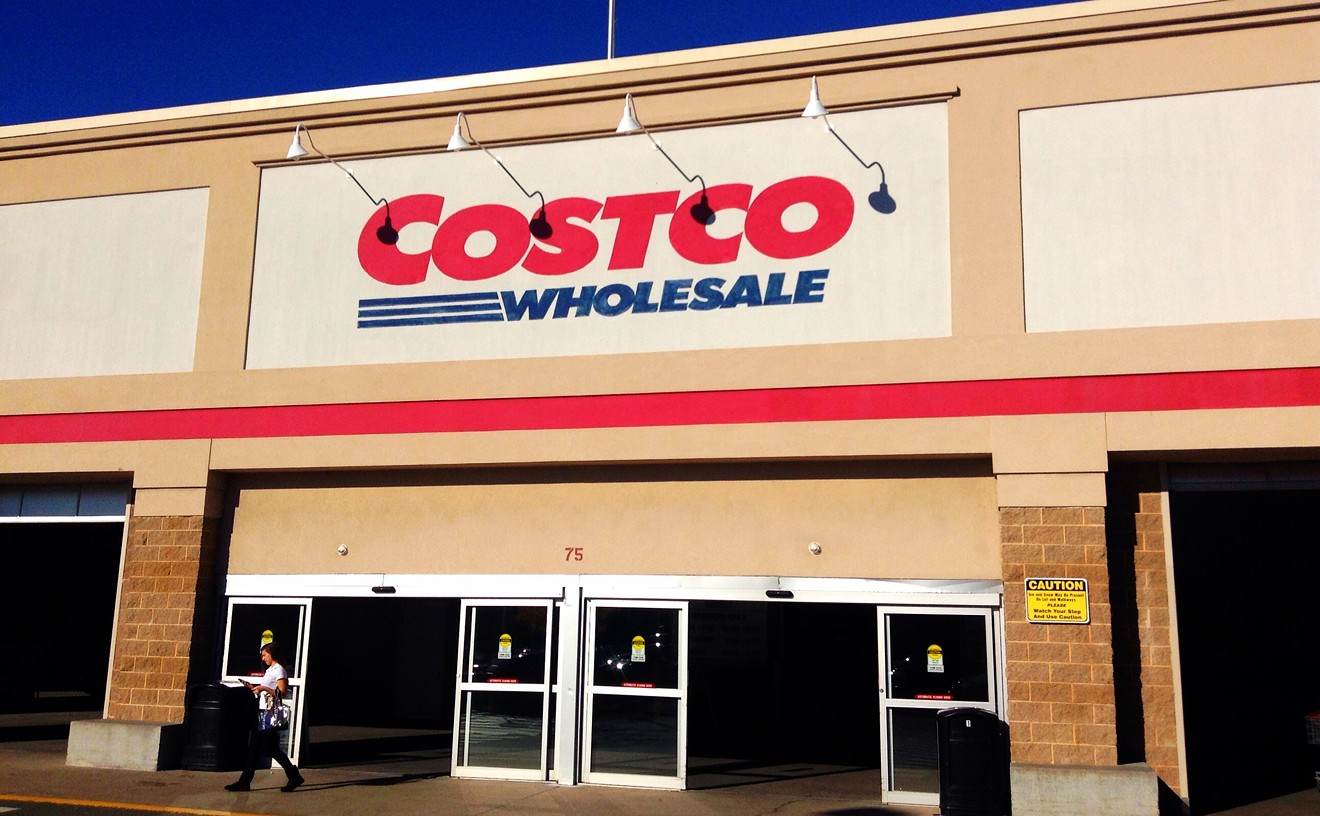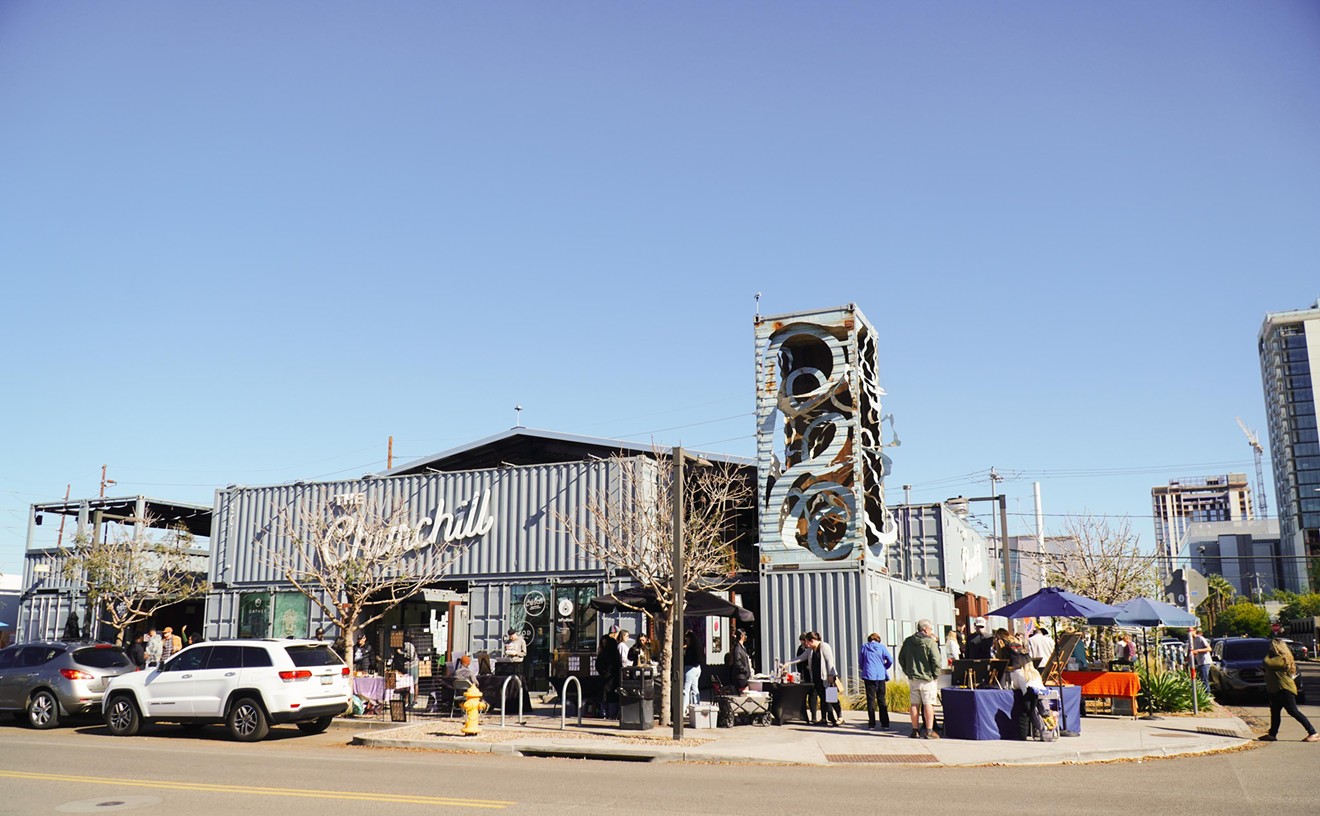For more of the best people, places and things to do in Phoenix, check out our 2015 Best of Phoenix awards.
There is no such thing as a straightforward interview with Chris Bianco.
An hour in, what should have been a discussion about pizza has turned into a deeply emotional conversation about scorpions and ants but mostly about the world and Phoenix and what it means to be a citizen of both.
It's six o'clock in the evening, and the dining room at the James Beard Award-winning chef's Town & Country location of Pizzeria Bianco has filled up. Some gush about the unassuming giant of the Phoenix food scene, who just happens to be seated within earshot. He blushes and loses his train of thought in embarrassment when he hears his name. He scribbles on blank white paper while he talks — figure eights and concentric circles, each ending at the start.
As it turns out, Chris Bianco is a pretty goofy dude. He is a master gesticulator. Over the course of a conversation, he has waved his arms and tugged emphatically at his hair, which stands straight up at the roots by the end of the interview. He speaks quickly with a thick New York accent. When he gets excited about an idea, his words slide out of the left side of his mouth, as though he were sharing a secret. He sounds, and looks, like he coulda been a contender, but his unrehearsed words, peppered with profanity, are singularly poetic, peaceful, and potent.
This interview is the last stop on a quest to find out how, over the past 30 years, Phoenix has come to be known for its pizza. The research thus far has pointed here, to the man himself, and there are only two questions for Bianco: Why pizza? Why here? The answer is so much more.
"I don't really have a big arsenal of words," Bianco says when asked how he wound up in Phoenix. Local legend tells of a New York man with Italian roots who came here looking for adventure on what was supposed to be a two-week visit. He somehow succeeded in building a globally recognized pizza empire in a town still struggling to find itself.
"Love is a word to explain how we make each other feel. Al dente is a word to explain the texture of a pasta. [Phoenix] made me feel something, and that something was: It made me feel welcome and it made me feel that something was possible if I just engaged in what was already there. That's the magic and the beauty and the opportunity."
There are certain types of people in the world who just shouldn't be trusted without rigorous vetting. Like people who sell cars, adults who really enjoy doing magic tricks, Juggalos, and anyone without a belly button, people who don't enjoy pizza should be met with a healthy amount of skepticism.
Pizza is the perfect food. It's sweet, it's salty, it's tangy, it's savory. And it is so much more than any of that. Pizza is the Great Food Unifier. It appeals to the simplest and the most sophisticated of palates. It's a favorite food of Americans young and old. From the Bagel Bite to the curry-coated naan-pizza, it can be customized to suit any taste, and from the $5 Hot-N-Ready to the gourmet wood-fired pie, it can accommodate any budget. It's a food to bring people together, a food to socialize around, a food to enjoy without pressure or pretense.
Chris Bianco shares this romantic view and waxes philosophical about it.
"There's something so emotional about pizza. It's one of the first foods that you eat out of your home. It has a little pointy end; we know where to begin and where to end. There are eight slices, so if there are four of us, it's easy to figure out — with a bowl of soup, it won't end pretty or fair, that's for sure. It's something that resonates with us. We take it with us, in a box. We sat on a hill with someone we loved or cared about or a friend and we shared something. Can you do something with it that is beyond sentimental? Therein lies the opportunity."
Given that Phoenix is the fifth-biggest metropolitan area in the nation, it's not surprising that the city has several great pizzerias. Chicago has its signature deep-dish pizza, and New York's best-eaten-folded thin-crust slices are available on every corner. But Phoenix has embraced pizza in all its shapes and forms. Classic wood-fired, chewy-crusted Italian flatbreads? Yes, please. Doughy, grease-dripping Americanized pies? Sure, we'll gladly take those, too. Pizza purveyors have popped up in recent years to meet the city's growing demand for pies of all kinds. And just as Phoenix has embraced pizza as a culinary art form, pizza has enhanced and accelerated the development of Phoenix's entire food scene.
But why pizza? Why here? Was it just Bianco and his romantic notions? What set the stage for his success?
Chefs, business owners, cultural experts, and critics all seem to have different takes on how Phoenix became a pizza town. Let's start at the beginning — in Italy.
Fabrizio Cali, board member and marketing lead for the Italian Association of Arizona, has a pretty good theory about how this classic dish became a hallmark item of the Phoenix food scene. When asked what he feels has been responsible for the surge in popularity of Italian cuisine in Arizona, his response is simple: "Surely, Italians."
Cali is on to something here. According to data provided by the Italian Association of Arizona, the state currently has "about 2,000 families that are first generation, born in Italy, about 10,000 people born in Italy that became American citizens, and about 200,000 citizens who are second- or third-generation American descendants from Italian backgrounds." That's a lot of Italians, Italian Americans, and American Italians living in the state — and the population is ever-growing.
Cali credits Phoenix's prime retirement conditions and the opening of Italian firms, such as ST Microelectronics, for the influx of these people to the area. With this movement came a demand for traditional Italian cuisine, and Cali expects the trend will continue. "Historically, the major Italian immigration was to the East Coast, especially to New York state. But Arizona also has a large Italian population, and our forecast is that it will increase more in the future."
Given this information, it makes perfect sense that some of our favorite local pizzerias — Cibo and Pomo Pizzeria Napoletana, for starters — were started by Italian immigrants to Arizona.
Cibo founder Guido Saccone, one of them, totally gets why Phoenix has seen such a boom in pizza popularity over the past few years.
"When we opened Cibo [in 2005], there were only about three wood-fire-burning pizzerias in the Valley. But at the same time, it feels normal because where I'm from, you can find a pizzeria literally on every other corner, and everyone has their favorite. Maybe the reason why it is becoming so popular is because wood-fired pizza-making has kind of a magical aspect to it. I'm always amazed at how simple things like salt, flour, water, and yeast and a little time make the dough rise, how the fire in the oven is always changing in movement and color, and how each pizza comes out slightly different from the other. I consider us pizzaioli to be 'sorcerers of the dough' without taking ourselves too seriously."
Sorcerers of the dough these pizzaioli may be, but Phoenix had to ferment quite a bit in order for them to rise.
Phoenix is a fairly new city, as far as urban centers go. It wasn't until after the 1950s (and the advent of residential air conditioning) that the area really became a site for industry that wasn't agricultural in nature. The town, and its surrounding areas, were military hubs during World War II, and they piqued the interest of visiting soldiers, many of whom came back with their families after the war ended. Phoenix's business-friendly culture attracted all sorts of entrepreneurs to the region. Technology and product distribution companies boomed here, and so did the population. And that's where things get complicated.
Until the 1990s, Phoenix was pretty much a blank slate when it came to food. Constant industrial evolution, rapid urban expansion, and youthful impressionability meant that the town had every opportunity to adopt a signature regional cuisine. But the adoption process took a little bit longer than expected. We certainly had food — and great food, at that — but the local culinary scene struggled to find its niche.
Arizona's tourism industry grew by leaps and bounds in the 1960s and 1970s and with it came a high demand for hotels and restaurants. Snowbirds came from the north to enjoy the sweet sunshine and gorgeous mountain views. Steakhouses and hotel restaurants offered a high-end culinary experience to wealthier guests, but the city's winter booms and summer busts were not quite enough to truly sustain a year-round, free-standing food culture. The cost associated with quality ingredients made gastronomic experimentation prohibitively expensive for both diners and restaurateurs alike.
Hotels were able to absorb some of the high food costs associated with gourmet cuisine, but standalone restaurants found it more difficult to stay afloat. Many of the newcomers to the region moved to Phoenix from the Northeast and Midwest, bringing with them a set of food expectations that were not exactly daring. Food from these regions tends to be mild, so spicy Mexican fare — the obvious choice for a signature regional cuisine — may have been just a bit too adventurous for many newcomers.
Arizona's growing middle class also found the price of fancy food difficult to swallow. Phoenix grew quickly and surely. It summoned new industry. Tourism blossomed. But despite it all, median incomes stayed fairly low, especially compared to similar-size cities. While other cities became known for their fine-dining experiences and regional cuisine, Phoenix stayed split between low-cost, unadventurous dining and tourist-centric, high-end cuisine. There simply weren't many restaurants that struck a chord with the middle class. Eating was a necessity; dining was a luxury.
James Beard Award-winning chef Christopher Gross described the challenges of being in the restaurant business during this period.
"People wanted more casual food, with the exception of the fancy steakhouse. People would spend a lot of money on a steak and margarita. You'd get a complaint about how much you'd charge, when by comparison, [your food was] almost free."
During the 1970s another phenomenon started to take hold: Italian food began to find its way into the hearts, minds, and mouths of the American people. Fabrizio Cali believes this trend was facilitated by a number of factors.
Pizza has enhanced and accelerated the development of Phoenix’s entire food scene. But why pizza? Why here?
tweet this
"You may not know that Italian cuisine was practically unknown in the United States until 1970. There were only some Italian restaurants in Little Italy, but basically they were only for Italians. Then, thanks to many different elements, Italian cuisine became probably the most popular in the country — for sure because of the quality, but also thanks to the increased possibility to import foods from Europe, and also because there have been a second generation of Italians that opened restaurants trying to modify the original Italian cuisine for the United States' population's tastes and culture."
Spinato's Pizzeria was one of those entities. This Italian-American owned shop came onto the Phoenix-area pizza scene in 1974. Owners Ken and Elaine Spinato moved to the Southwest from Chicago for the same reason many people do: because Chicago is cold. Their son, Anthony Spinato, describes his parents' motivations.
"At that time, Shea Boulevard was a dirt road; there was literally nothing. My dad said, 'If we need one thing out here, it's definitely a good pizza.'" But Spinato's faced many of the same difficulties described by Gross. "It was always quality pizza — our cheese is 100 percent whole milk mozzarella, we made our sausage, our tomatoes were fresh-packed — everything we did was on the higher end. Phoenix back then was Peter Piper, two-for-one pizza deals, pizza and wings specials," he says. "People would call up and ask how much for two larges, and I'd say, 'One large is 14 bucks,' and they would say, 'You're crazy. I can get two pizzas for $9.99 down the street.'"
This brings us back to Chris Bianco.
The chef grew up in Ossining, New York. He came to Phoenix in 1985. Bianco is a family man first, which shows through in every aspect of his business.
"I'm incredibly blessed and very lucky to have a family that supports me in every way," he says. "Even though we didn't have so much monetarily, I was the richest person I knew because I was loved, I had great food, I had everything I needed. I think I used that motivation to understand and try to give now what I was fortunate enough to receive."
Bianco's father was a portrait painter, and his works line the walls of Pizzeria Bianco's Town & Country location. His mother designed wedding veils. Now retired, she comes to the restaurant every Tuesday and prepares desserts.
"They both came from a more artistic side," Bianco says. "Nothing to do with food. We ate great food all the time, in a very economical manner. Food with great humility. That was part of my every day. A simple pasta, the simplest roast chicken with potatoes. I think to do that is still an elevated art form, in a way."
Chris Bianco started making pizza — classic, unapologetic pizza. He slung pies at a European grocery (now AJ's Fine Foods at Central and Camelback roads in Central Phoenix). When the market transferred ownership, his lease lapsed, and a dirty little secret thing that Phoenicians don't like to talk about happened: Bianco left Phoenix for two years and moved to Santa Fe, New Mexico.
While working at a Santa Fe restaurant owned by Giovanni Scorzo (who currently operates Andreoli Italian Grocer in Scottsdale), Bianco says he was introduced to food in a way he had never known it.
"In Santa Fe, there was a farmer, Elizabeth Sebastian, who worked on a farm in northern New Mexico. It was life-changing. I never saw 17 varieties of organic eggplant. It's a magical, magical place. [Sebastian] would bring things into the restaurant that would blow my mind . . . the first time I saw zebra tomatoes and purple cherokees and all these incredible things."
So maybe Phoenix's exploding food scene had absolutely nothing to do with Chris Bianco — maybe he was just in the right place (Santa Fe?!) at the right time. Maybe Giovanni Scorzo and Elizabeth Sebastian actually deserve all the credit.
But neither Scorzo nor Sebastian managed to do what Bianco did. When Bianco returned, he opened one tiny restaurant and proceeded to transform the local food scene from the ground up.
"What if the food, no matter how humble it was, was as elevated as it could be?" Bianco asks. "In Phoenix, we've got it as good as anyone, especially for pizza. We have dry wood; it's easy to build a fire. We've got the largest grower in America of durum wheat. Farmers in the East Valley export it to Italy because ours is such a high quality."
Pretty much everyone familiar with Phoenix's food history agrees that Bianco did something huge here — not just in pizza, but in cuisine as a whole. His commitment to simple preparation, heirloom ingredients, and Italian flair made him a fast favorite among local and global foodies — but also prompted some backlash from Phoenix residents.
Longtime Phoenix food critic Nikki Buchanan describes a palpable shift that occurred when Pizzeria Bianco came on the scene.
"Phoenix was in no way a food town, yet. It was always white-washed or touristy. Unsophisticated. Soulless and mainstream. It was expensive. The notion of walking into a grocery store and getting a little funky pie, that's new to us. We're just now, in the last few years, getting this understanding of what it is to be funky."
But not everyone liked funky, says Buchanan. "People said, 'It's not worth it,' but people didn't know. I think he set the bar for us, and I think there are very few people that have hit it yet."
Bianco sees things differently. To hear him put it, he never intended to spark a revolution, and he never meant it to be about pizza. He just wanted to do something really well, with ingredients that were really good.
"I don't love pizza. I don't love pizza more than I love the things I love," he says. "Pizza wasn't conceptual. It was something I did growing up. I was able to, thankfully, earn a living out of it along the way. I was able to study it: How do I take something that was just part of my DNA? How do I make that hold integrity and be transparent and be proud of it?"
But Christopher Gross, Anthony Spinato, and Guido Saccone echo Buchanan's sentiment. "I respect what Chris does. I would find it boring, but I respect him tremendously," Gross says.
Spinato agrees, adding that the work Bianco has done to inform patrons about the importance of good ingredients has trickled into his family's business as well.
The opening of Pizzeria Bianco "brought education to a lot of customers who didn't know how good pizza can be or how high-end pizza can be," he says, adding that Bianco "has shown pizza in a different way. People respect what you do more, and they don't argue with a $20 pizza anymore. They see that this is a good thing, and they get what they pay for."
Saccone argues that the success of Bianco has helped propel other local restaurants — and other local pizza — in a positive direction.
"Restaurants that gain national attention for Phoenix give the Valley a stronger presence in the U.S. culinary scene and ultimately bring more attention to the restaurants in the surrounding area," he says. "It is great for other restaurants around Phoenix because we can gain some exposure from it, and we are always grateful for that."
This movement, sparked by Bianco, is constantly evolving, in theory and in practice. When asked why he chose to focus his efforts here, he says, "I've had almost 30 years to think about why it mattered — why didn't we lower the food costs, buy cheap mozzarella in bulk, tell people the tomatoes were a secret recipe. This was — it still is — a restaurant for this community. It's your restaurant. I just pay the bills."
What Bianco did wasn't anything special. He created simple food and created it well, and that simplicity resonated with the people of Phoenix. But what he represents, back then and to this day, is something much more complex. Bianco found the right place, a town with such diversity yet so little cohesion. He found it at the right time: as the town was in the middle of unmitigated growth in all directions. And he found the right vessel to get people to think deeply about food in an easy way, with a point at the start and a crust at the end.










